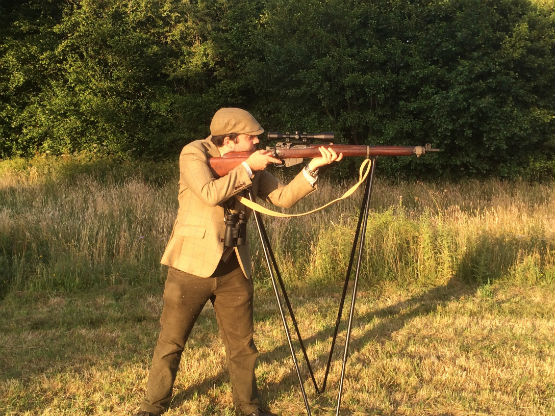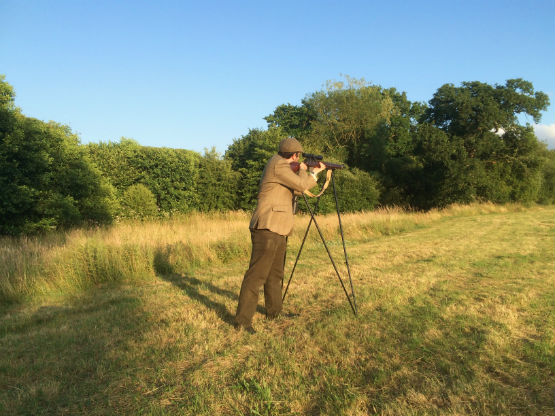In a follow up to his recent article 'A Blast from the Past' Guy Hunter takes a more detailed look at the .303 and considers its use in deer management.
(Above: Guy in action with his .303 stalking Roe Buck with County Deer Stalking)
The .303 British (or, in modern European terms, 7.7x56mmR – where the R stands for Rimmed) is without doubt an old fashioned choice of calibre nowadays. Certainly a quick straw poll of custom riflesmiths did not reveal any demand at all for new rifles in this calibre; indeed, one very well-known London gunmaker attempted to sell me the last of their test-firing stock of soft-point .303 completely unprompted as 'no-one wants it anymore.'
I found this unusually depressing as I, along with a large portion of the UK rifle community I suspect, have quite a soft spot for the .303 and the rifles that were made for it. This is, after all, the cartridge that has reputedly put down more game around the world than any other.
This cartridge started life fighting the Boer Wars and ended its service life in the depths of the Cold War, surviving Flanders mud, Libyan desert and frozen Norwegian forests along the way. It has quite the history but it is probably its service length that proves its weak point as well.
 Originally designed as a black powder cartridge and first adopted in 1888, the .303 would undergo many changes in propellant and bullet design as it was repeatedly modified in order to keep pace with technological advances. Newer designs and different calibres improved upon the .303 and offered performance that the relatively antiquated design could not quite match. But the pressures of war production and of the massive challenge of replacing an Empire's stock of .303 rifles kept it in use. In short, it worked well enough for what was required of it, which was to allow a trained infantryman to place rapid, aimed shots at distances out to around 600 yards and kill with reasonable reliability.
Originally designed as a black powder cartridge and first adopted in 1888, the .303 would undergo many changes in propellant and bullet design as it was repeatedly modified in order to keep pace with technological advances. Newer designs and different calibres improved upon the .303 and offered performance that the relatively antiquated design could not quite match. But the pressures of war production and of the massive challenge of replacing an Empire's stock of .303 rifles kept it in use. In short, it worked well enough for what was required of it, which was to allow a trained infantryman to place rapid, aimed shots at distances out to around 600 yards and kill with reasonable reliability.
(Above: An English Lee-Enfield Pattern 4 Mk I in 303 British)
In reality, at ranges of up to 500 yards, the .303 offers similar performance to the .308, the 7.62x51 cartridge that superseded it and the .30-06 as a standard NATO long rifle cartridge. It offers a wide range of bullet weights, ranging from 215gr (Kynoch, 2050fps, 2007ft/lbs) to commonly available 150gr expanding options (2700fps, 2428ft/lbs). Weights as low as 125gr have been used on light-bodied game with good success although the .303's intrinsically low BC means these slow significantly after 200 yards or so, which may greatly reduce stopping power at long range, despite leaving the muzzle at around 2900-3000fps. Standard service ammunition was 174gr Full metal jacket and the commonest factory ammunition available today is 174gr for target shooting and either 150gr or 180gr (2400fps, 2302ft/lbs) for expanding projectiles.
Kynoch, Speer, Hornady, Federal and Privi Partizan (amongst others) continue to produce .303 ammunition in a variety of weights and bullet designs, although finding expanding variants will almost certainly require your local RFD to order it for you.
 So, what does this mean for the stalker? Well, surplus rifles are readily available and have been steadily climbing in price over the last few years. Expect to pay £400-500 for a good example of an SMLE (the World War One Lee Enfield) or a No.4 (the World War Two variant). Many of these battle-rifles were 'sporterised' (some might say butchered) in the 1950s, offering a lighter, more elegant option for a hunter. Somewhat lacking in pedigree as a result, they are cheaper than the 'military spec' rifles. The much rarer No.5 Jungle Carbine (known as the 'Jungle Hammer' due to its fierce recoil and muzzle flip) will set you back around £900 for a good example. Target rifle conversions, with heavy barrels, tuned actions and adjustable stocks are also readily available and, despite offering much improved accuracy, are often quite cheap due to their being rendered obsolete by more modern .308 target rifles.
So, what does this mean for the stalker? Well, surplus rifles are readily available and have been steadily climbing in price over the last few years. Expect to pay £400-500 for a good example of an SMLE (the World War One Lee Enfield) or a No.4 (the World War Two variant). Many of these battle-rifles were 'sporterised' (some might say butchered) in the 1950s, offering a lighter, more elegant option for a hunter. Somewhat lacking in pedigree as a result, they are cheaper than the 'military spec' rifles. The much rarer No.5 Jungle Carbine (known as the 'Jungle Hammer' due to its fierce recoil and muzzle flip) will set you back around £900 for a good example. Target rifle conversions, with heavy barrels, tuned actions and adjustable stocks are also readily available and, despite offering much improved accuracy, are often quite cheap due to their being rendered obsolete by more modern .308 target rifles.
The .303's terminal ballistics are impressive on medium game, its generally heavier weight and slower velocities compared to other 'deer' rounds offer good penetration and excellent stopping power without much in the way of the meat damage you might see with a lighter, faster round. The heavy rounds come into their own when woodland stalking, where the ranges are close and a heavyweight bullet is less likely to be deflected by the undergrowth.
So, what are the downsides? Ammunition availability has already been touched on but equally important is the challenge of finding a rifle that is a 'shooter.' Even a mint action and barrel will not guarantee success, as wartime build tolerances were understandably slacker, both due to volume pressure and to allow for mud, grit and sand in the working parts and still keep the rifle firing – 'acceptable' accuracy for a war production No.4 was around 3-3.5MoA but with the right rifle and ammunition, 1-1.5MoA is entirely achievable.
If you intend to use the rifle for stalking, try it first. Ask the owner what ammunition it 'likes.' If trying it out isn't an option, for example at a gun show, taking along an inert .303 round and just inserting the bullet head into the muzzle will give you an idea of how worn the muzzle end of the rifling is – if the bullet slides all the way in up to the casing neck, keep on walking! If it won't go more than half-way, things are looking good.
The other major downside of the .303 is that it is, for all intents and purposes, illegal for use in Scotland due to its low muzzle velocity, thus banning it from contention in many 'best calibre for UK deer' discussions. Of course, handloads may take it over the legal requirement but pushing the limits in this manner must be done with extreme caution and should only be attempted by experienced loaders and tuned for an individual rifle.
If one is careful to find an unabused example (shot-out bores and worn throats being the most common complaint), you can have a rifle that will reliably drop all of the UK's deer species without any trouble. With a little trial and error over ammunition (these rifles, despite their incredible mechanical robustness, can be remarkably sensitive to differing bullet and powder weights) and a solid scope mount, such as those made by Armalon, you have an elegant hunting rifle with a 10-shot magazine for maybe 600 pounds. More than that, you own a piece of British history, which is something your synthetic stocked, moderated, bipodded, tuned-action .308 is unlikely ever to be.
To read Guy's previous article, 'A Blast from the Past' follow this link: a-blast-from-the-past
To read more about Rifle Calibres including the .303, follow this link to our rifle calibres page: rifle-calibres





















